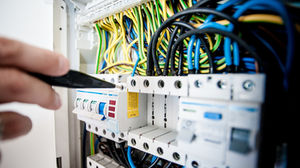Search
Thermal Scanning: Turning Up The Heat
- Corsence
- Jan 19, 2017
- 4 min read

If you are within the electrical industry you would have at some stage heard of or even considered conducting thermal scanning yourself. It’s a simple process, right? Purchase a thermal camera, complete a few days training and away you go. Thermal scanning can add another revenue stream to your business as well, plus you don’t have to pull cable or crawl through the roof on a 40-degree day.
As a building manager or insurer, thermal scanning primarily provides your building and It’s occupants with risk mitigation against fire. An extremely important service considering that the leading cause of fire in commercial and industrial buildings is electrical. No hot spots found, no major issues.
Don’t get us wrong we believe thermal scanning has served its purpose and helped reduce the risk of fire across commercial and industrial buildings. However thermal scanning alone can miss key safety hazards, condition and compliance items. It is our belief that thermal scanning needs to be coupled with another form of inspection which provides greater risk management and identification. The current thermal scanning practices have unknowingly created a few misconceptions and a false sense of security surrounding its effectiveness of identifying potential fire causing hazards.
"Inspections are based around risk identification & mitigation"
If we look at conducting thermal scanning on a distribution board as an example, generally, this will take around 5 minutes to complete the scan. That 5 minutes of scanning is less than 1% of the distribution boards annual operating life cycle. Throughout this 5-minute period, if no radiation (hot spot) is detected, the distribution board has passed the thermal scan and you move on.
We can see through an example such as this that key hazards can be missed simply through timing and only looking for thermal radiation. A thermal camera is not going to pick up that the termination is damaged or if supply doesn’t exist therefore producing no heat/thermal radiation.
A prime example (shown below) is a load side connection of a contactor that hasn’t been engaged due to time periods or site control requirements. This contactor shows no signs of abnormal heat in the thermal image yet you can see there is a clear signs deterioration of connection due to heat.

"The switchboard cover has been removed - WHY isn't more being done??"
Once the escutcheon is placed back on, in most cases it’s a whole year before the distribution board is scanned again. In this twelve months, there may be a fault or termination creating a hot spot that leads to a fire. Is that the contractors fault? We don’t think so. The contractor has only been engaged to thermal scan the distribution board, a quick check of the distribution boards terminations without the thermal camera may have picked up signs other than thermal radiation that a hot joint may exist.
Many electrical contractors and contracting companies have provided great thermal scanning services for a long period. With the competition increasing dramatically between contractors to win thermal contracts the gap is widening. For example, we recently attended a refresher course ran by FLIR based on teaching the fundamentals of thermal scanning. Several contractors were asking questions such as “What does the main switchboard look like that we should be thermal scanning?” and “How do I find it”. Concerning on a few fronts, least to mention whipping the cover off a 3000A main switchboard presents multiple safety concerns without sufficient experience and training.
Trying to explain to a building owner why the switchboard you scanned only two months ago has caught on fire is not an easy task. Especially when you show him the thermal scan and report with board receiving a pass "no abnormal thermal radiation present". If you put the shoe on the other foot, we have no doubt that if this was our office or your house the same questions would be asked.
"My thermals are done every year without an issue, why should I do more??"
As mentioned before, we believe thermal scanning should be coupled with another service. An inspection based around risk identification & mitigation that produces a checklist of items inspected and a report for the building owners to refer to. This way it can be clear what has been inspected, what has been detected and how to best rectify these issues.
We asked ourselves why hasn’t this been completed before? A few things came to mind. Firstly time and associated expense to complete. To conduct a comprehensive inspection on a distribution board for example would take approximately 30min without any additional time included to report. Secondly, what should be inspected and reported on? As you can see the thermal scanning budget has just increased 10-fold and the emphasis on contractor knowledge risen.
We dedicated ourselves over the past year to debunk these two issues and have developed our own checklist and reporting procedures to shorten this time to 5-15min per distribution board. We also refined these checklists over 1000 switchboard inspections (Main Switchboards, Distribution Boards, Tenant Distribution Boards, Meter Panels etc.) and included inspection manuals for reference. Our checklists & inspection manuals coupled with thermal scanning provide a significant improvement in detecting safety/electrical hazards, a condition and compliance check (with legislation references) and most importantly fire risk mitigation. It was no mean feat that took a considerable amount of time to condense items we deemed necessary to inspect.
If you are interested in an increased level of risk mitigation or you are wondering exactly what to inspect, check out our condition and compliance inspections for distribution and main switchboards on the image & link below.















